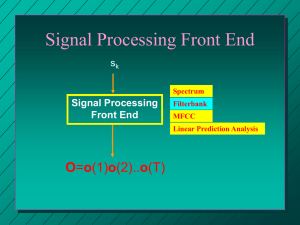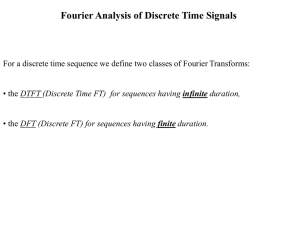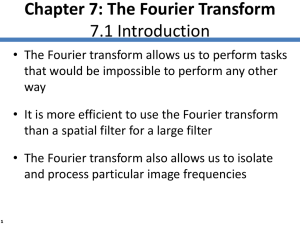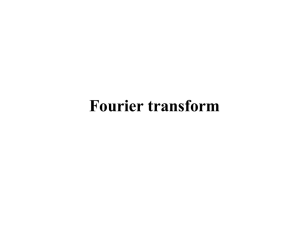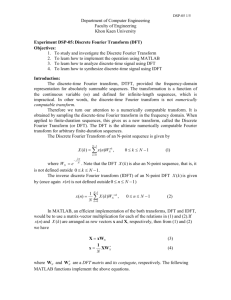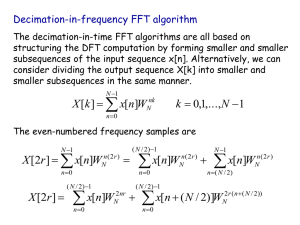topic_7_rev
advertisement
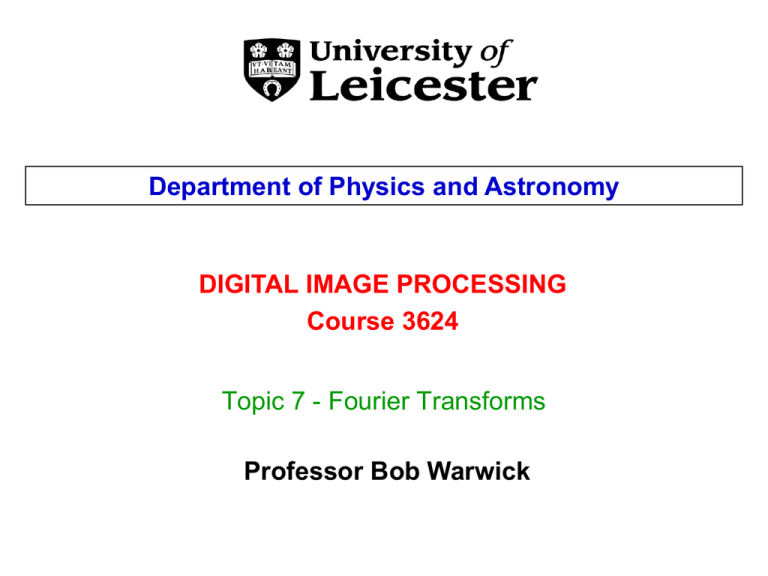
Department of Physics and Astronomy DIGITAL IMAGE PROCESSING Course 3624 Topic 7 - Fourier Transforms Professor Bob Warwick 7.1 Review of The Fourier Transform • Many DIP techniques rely on the application of an image transform of which the Fourier Transform is the most popular. • The Fourier domain provides very important insight into the information content of the data. Outline of this Topic 7.1 Introduction to the Fourier Transform (FT) 7.2 The Discrete Fourier Transform (DFT) 7.3 The Properties of the DFT 7.4 Computation of the DFT (via the FFT) 7.1 Introduction to the FT In 1-d, assuming continuous variables: f (x) Û F(u) f (x) Fourier Transform Pair F(u) = f (x) = ¥ ò f (x)e- j2p ux dx ò F(u)e j2 p ux du -¥ ¥ -¥ may often be real, whereas F(u) is generally complex, ie F(u) = R(u)+ j I(u) = F(u) e jq (u) Spatial Frequency The spatial frequency of this signal would be: u=l -1 with units of either: cycles per m (physical space) cycles per pixel (image space) F(u) is a two-side function of u (i.e. extends to +ve and –ve frequencies) If f(x) is real: F(u) = F * (-u) \ F(u) = F(-u) Fourier Transform of a Rectangular Function f (x) Û F(u) sin(p uX) ® sinc(p uX) p uX Amplitude = F(u) = AX sinc(p uX) Phase = q (u) = -p uX Fourier Transform of a Gaussian f (x) F(u) f (x) Û F(u) sx su x f (x) µ e -x 2 /2s x2 Û F(u) µ e u -u2 /2s u2 where s u = 1/ 2ps x Notes: •The Inverse Relationship – narrow function in the spatial domain results in a wide function in the Fourier Domain. •In this case F(u) is not complex ie q (u) = 0 The Impulse or Delta Function A Table of FT Pairs f (x) Û F(u) RECTANGULAR FUNCTION GAUSSIAN FUNCTION DELTA FUNCTION COSINE FUNCTION SINE FUNCTION SHAH FUNCTION The 2-D Fourier Transform F(u, v) = f (x, y) = ¥ ¥ ò ò f (x, y)e ò ò F(u, v)e j2 p (ux+vy)du dv -¥ -¥ ¥ ¥ - j2 p (ux+vy) -¥ -¥ Example: The "Box Car" Function y dx dy x v u More on Convolution Integrals f (x)* h(x) = ¥ ò f (a )h(x - a )da -¥ f (x, y)* h(x, y) = ¥ ¥ ò ò f (a, b )h(x - a, y - b )da d b -¥ -¥ Example: Convolution of a Shah Function with a Rectangular Function The CONVOLUTION THEOREM: the Fourier Transform of the product of two functions equals the convolution of the Fourier transforms of the individual functions. f (x) ´ h(x) Û F(u)* H (u) Conversely: f (x)* h(x) Û F(u) ´ H (u) 7.2 The Discrete Fourier Transform (DFT) Consider a 1-d sampled dataset of dimension N: f0 f1 f2 f3 fx¢ f x¢ index N-1 0 ® N -1 x continuous variable 0 ® X X N x = (x¢ + 0.5)Dx » x¢Dx Dx = x=0 F(u) = F(u) = x=X ¥ ò f (x)e- j2p ux dx @ -¥ N -1 X ò f (x)e- j2p ux dx 0 å fx'e- j2p ux¢Dx Dx x¢ index, u continuous variable x¢=0 We need to evaluate F(u) on a grid of N points (in u space). A good choice for the spacing is Δu=1/X (=1 cycle across the full extent of the image) F0 F1 F2 F3 u=0 Fu¢ F N-1 Du = Fu¢ = Dx å fx' e- j 2 p u¢x¢ Dx Du Also: x¢=0 0 ® N -1 u continuous variable 0 ®U u =U N -1 u¢ index 1 1 \U = NDu = X Dx fx¢ = Du N -1 (ie 1 cycle per pixel) å Fu' e j 2p u¢x¢ Dx Du u¢=0 The DFT continued Finally we set DuDx = 1 N 1 Fu = N fx = , we redistribute the normalization term and drop the dashes: N -1 åf x e - j 2 p ux N u = 0 ® N -1 x=0 N -1 åF u e + j 2 p ux N x = 0 ® N -1 u=0 EXAMPLE: Determine the DFT of a 4-point dataset with input values: f0 = 1 f1 = 1 f2 = 0 f3 = 0 Fu = 1 3 fx e å 4 x=0 j 2 p ux 4 u=0®3 1 F0 = (f0 + f1 + f2 + f3 ) 4 1 F1 = (f0 - jf1 - f2 + jf3 ) 4 1 F2 = (f0 - f1 + f2 - f3 ) 4 1 F3 = (f0 + jf1 - f2 - jf3 ) 4 1 = 2 1 j = 4 4 =0 = 1 j + 4 4 |Fu| X X X X X X X X X -4 -3 -2 -1 0 1 2 3 4 Why the periodicity? X X 5 6 X 7 u 7.3 Some Properties of the DFT (a) SAMPLING THEORY Input data stream (continuous variables) Represent sampling by a comb of delta functions s(x) [a Shah Function] The sampled version of f(x) can be represented by s(x)f(x) Assume F(u) is zero outside range -w<u<w S(u) is a Shah Function with spacing Δu=1/Δx In the Fourier domain we have the convolution S(u)*F(u) This explains the periodic nature of the DFT ie it repeats at a rate (in u) of 1/Δx However, if the bandwidth of the input signal w is too high , such that w > 1/2Δx, then the result will be The overlap of the repeating functions results in information loss ALIASING Some Properties of the DFT cont. (b) SHANNON’S SAMPLING THEOREM To avoid information loss it is necessary to sample a signal at a rate equivalent to at least twice the maximum frequency component present in the signal. That is we need w < 1/2Δx, where 1/2Δx is known as the Nyquist frequency. ✖ ✔ To avoid aliasing sample at a higher rate (or alternatively filter the input data stream to remove signals above the Nyquist frequency) The process to recover the original data stream! Some Properties of the DFT cont. (c) CHARACTER OF THE DFT Example: 1-d 8-point transform. 1´ Du = fx 0 1 2 3 4 5 6 7 x 1 1 = 1 cycle per 8 pixels X NDx 1 cycle per 2 pixels N 1 ´ Du = 2 2Dx Nyquist frequency N ´ Du = |Fu| 0 N=8 1 2 3 4 5 1 The sampling rate Dx 6 7 x N=8 (d) The 2-D DFT N -1 N -1 j 2 p (ux+vy) N N -1 N -1 j 2 p (ux+vy) N 1 Fuv = fxy e å å N x=0 y=0 + 1 fxy = Fuv e å å N u=0 v=0 (e) The Optical Transform u = 0 ® N -1 v = 0 ® N -1 x = 0 ® N -1 y = 0 ® N -1 A trick to shift the (u,v) origin from the top left corner to the centre of the Fuv image is to multiply the input image by alternate 1’s and -1’s before computing the DFT i.e. fxy ´ (-1)x+y The Optical Transform 7.4 Computation of the DFT In DIP applications we need to compute the 2-d DFT j 2 p (ux+vy) N -1 N -1 1 u = 0 ® N -1 N Fuv = f e xy å å N x=0 y=0 v = 0 ® N -1 The “separability” property of the 2-d transform leads to a simplification: N -1 Rearranging: 1 Fuv = e å N x=0 j 2 p ux N -1 N fxy å e Writing: Then: 1 Fuv = Fxv e å N x=0 x u = 0 ® N -1 v = 0 ® N -1 u = 0 ® N -1 v 1 Hence, the 2-d DFT reduces to the computation of a series of 1-d transforms. v = 0 ® N -1 j 2 p ux N y fxy j 2 p vy N y=0 j 2 p vy ù é N -1 1 ê Fxv = N å fxy e N úú ê N y=0 ë û N -1 - Fxv x v 2 Fu u v Step 1 involves N 1-d transforms along the rows of the original image (x N scaling) Step 2 involves N 1-d transforms down the columns of the intermediate image In total we require 2N 1-d transforms, each of which involves N x N complex multiplies and adds ie N4 2N3 calculations The FFT Algorithm Implementation of the FFT Algorithm A Fortran FFT Routine Re-ordering Successive doubling Calculating the Inverse Fourier Transform Fu = fx = N -1 1 fx e å N x=0 N -1 - å Fu e j 2 p ux N + x = 0 ® N -1 j 2 p ux N u = 0 ® N -1 u=0 If we take the complex conjugate of the inverse transform and scale by 1/N: 1 * 1 fx = N N N -1 * F å ue - j 2 p ux N u=0 To calculate the Inverse Transform with a software procedure that computes the 1-d “forward” transform: (i)Convert Fu Fu* (ii) Apply the forward transform (iii) Scale the result by N (iv) Convert fx* fx Example of a 2-d DFT calculation fxy |Fuv | (-1)x+y log |Fuv | And the Inverse …. (-1)x+y Ignoring the phase! Ignoring the amplitude! Example of a 2-d DFT log |Fuv| Richard Alan Peters II Magnitude-only Reconstruction Phase-only Reconstruction

